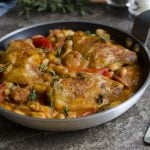Week 3 – Optimising collagen production & promoting healing
Known as the beauty elixir, collagen is the glue that holds our skin together as the main component of connective tissues. Collagen works its magic alongside elastin to keep skin bouncy and taut, and whether you have dry or oily skin, collagen can help to keep your skin healthy.
Luckily there’s strong evidence to show that the foods we eat can boost collagen production. Here’s 3 simple steps to restore collagen levels in your skin.
1. Eat foods rich in collagen
Collagen can’t be created from thin air. It is a structural protein made up of three amino acids – glycine, proline, and hydroxyproline. A simple way to maintain collagen in your skin is to eat collagen itself, derived from animal products. Bone broth, chicken skin, fish skin and eggs are particularly rich sources.
Collagen supplements derived from these foods are an easy way to top up your levels too. If you go down the supplement route, look out for collagen that has been hydrolysed as this breaks down the amino acids into smaller molecules, making it much easier for your body to absorb.
2. Increase collagen production within your body
If you aren’t keen on sipping on bone broth or having daily supplements, another effective way to build collagen is to provide your body with the building blocks to make it. In addition to meat and fish, the three key amino acids can also be found in plant-based foods, dairy and eggs.
Glycine is rich in green leafy veg (watercress, spinach and seaweed), sunflower seeds, sesame seeds, soy beans, peanuts and eggs.
Proline is predominantly found in grains (wheat, rye, barley, oats), seaweed, sunflower seeds, sesame seeds, pumpkin seeds, soy beans, peanuts, kidney beans, peas, cheese, milk and eggs.
Hydroxyproline is found in flaxseeds / linseeds, peanuts and cheese.
Combining these foods to ensure that you have all three amino acids gives your body the raw materials to build collagen. Peanut butter on wholegrain seeded toast, or a spinach omelette with cheese would be winners.
Your body will also need a helping hand from vitamin C, key in the processes involved to form collagen structurally. Red peppers, kiwi fruit, and broccoli are all very rich sources, even higher than citrus fruits.
To highlight just how important vitamin C is, a deficiency can result in scurvy, a disease where the connective tissues in the skin cannot hold together, and skin becomes extremely dry, scaly, and breaks down.
3. Protect the collagen you have
While collagen production naturally decreases with age, we should be reserving the precious collagen we have.
The culprits for speeding up the breakdown of collagen include sugar, processed foods (containing heat damaged oils), excessive sun exposure, pollution, alcohol and smoking. While in moderation these are unlikely to do significant harm, overdoing it can take its toll on your skin.
Antioxidants found in brightly coloured fruits and vegetables can help to protect against these free radicals which break down collagen. Vitamin A is particularly protective, sourced from orange coloured such as carrots, apricots and green leafy veg (kale, spinach). These antioxidants also have a key role in healing your skin.
Challenge 5: Prepare a big batch of food high in protein and store for later
– Store in tupperware boxes in the fridge or freezer
– Label meals with paper tags, e.g. ‘Bean chilli’
– Make meals which freeze well – curries, chilli, soups
– Include plant based high protein foods (lentils, beans, nuts)
Challenge 6: Track your protein intake for 3 days using the ‘MyFitnessPal’ app
– Aim to eat 1g of protein per kg of body weight (e.g. 70g of protein if you weigh 70kg)
– Try a protein powder if you do not eat meat and fish, or if your levels are low
– Save a screenshot on your phone of your protein intake each day
Download MyFitnessPal app 👇


Recipes for week 3








Recipe of the week
Fish & butternut squash curry
Ingredients
- 2 tbsp coconut oil
- 1 butternut squash
- 8 handfuls brown rice
- 1 onion
- 6 cloves garlic
- 1 red chilli or 1 tsp ground chilli
- 4 tbsp garam masala (spice mix powder)
- 4 fillets haddock
- 1 tin chopped tomatoes
- 100 g spinach
- 1 tsp ground ginger or 1 tbsp grated fresh ginger root
- 2 tbsp fresh coriander chopped
Instructions
- Preheat the oven to 180 deg C and prepare an oven tray with 1 tbsp melted coconut oil.
- Cut the butternut squash in half, remove seeds and chop into generous chunks. Bake in the oven tray for 50 minutes, turning halfway.
- Simmer the brown rice in at least double the amount of water for 25 minutes with a lid on.
- Finely chop the onion and in a large pan, fry on a medium heat in coconut oil until soft.
- Add the sliced garlic, fresh chilli chopped and garam masala and stir for a few minutes on a medium to high heat.
- Add the haddock, chopped tomatoes, chopped spinach and ginger. Allow to simmer for 15 minutes, stirring occasionally.
- Drain the brown rice and leave to sit for a few minutes to absorb any remaining water.
- Lastly, stir the finely chopped fresh coriander into the curry.
- Serve the rice, curry and roast butternut squash on top.
